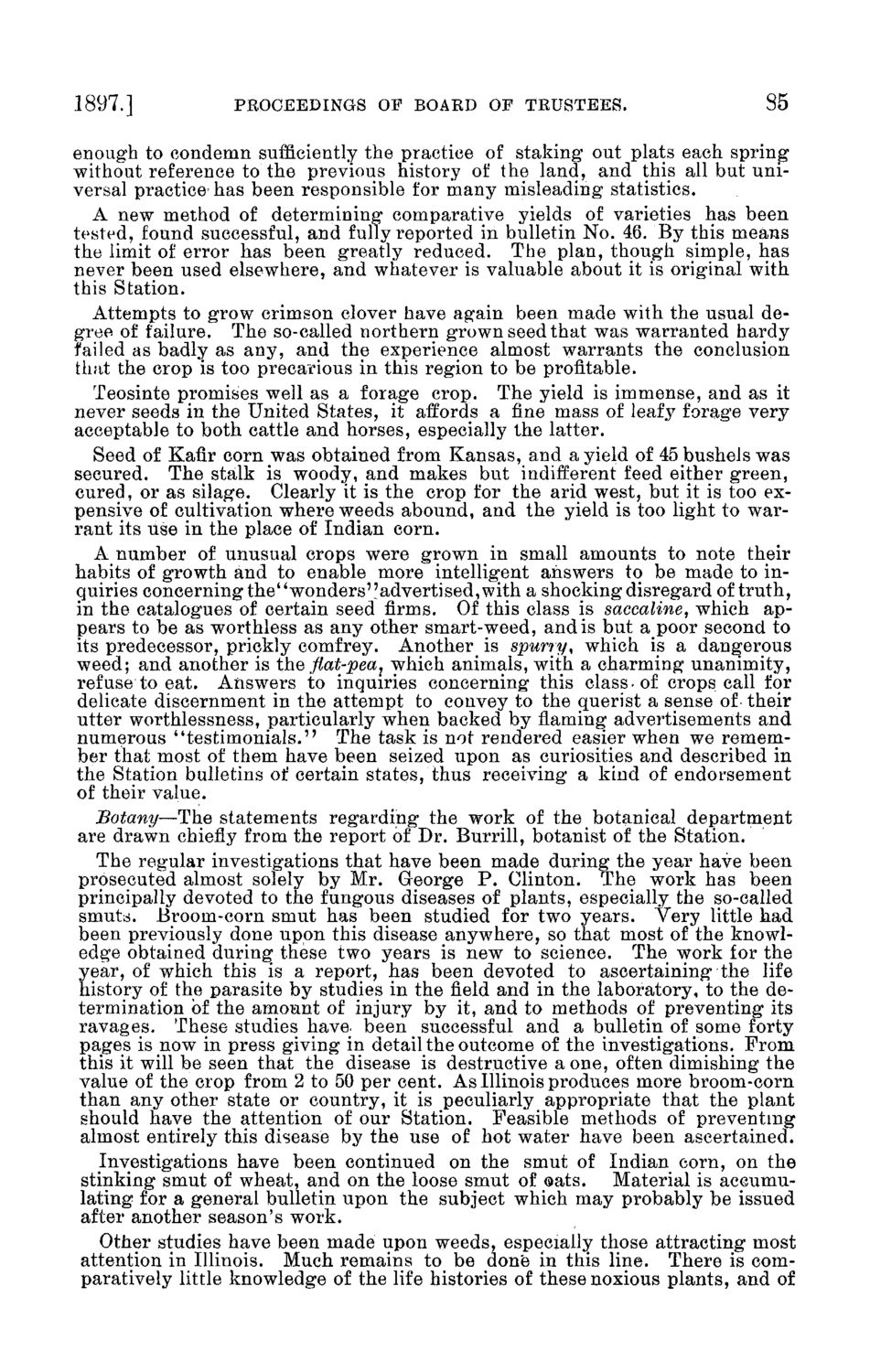| |
| |
Caption: Board of Trustees Minutes - 1898
This is a reduced-resolution page image for fast online browsing.

EXTRACTED TEXT FROM PAGE:
1897.] PROCEEDINGS OF BOARD OF TRUSTEES. 35 enough to condemn sufficiently the practice of staking out plats each spring without reference to the previous history of the land, and this all but universal practice- has been responsible for many misleading statistics. A new method of determining comparative yields of varieties has been tested, found successful, and fully reported in bulletin No. 46. By this means the limit of error has been greatly reduced. The plan, though simple, has never been used elsewhere, and whatever is valuable about it is original with this Station. Attempts to grow crimson clover have again been made with the usual degree of failure. The so-called northern grown seed that was warranted hardy failed as badly as any, and the experience almost warrants the conclusion that the crop is too precarious in this region to be profitable. Teosinte promises well as a forage crop. The yield is immense, and as it never seeds in the United States, it affords a fine mass of leafy forage very acceptable to both cattle and horses, especially the latter. Seed of Kafir corn was obtained from Kansas, and a yield of 45 bushels was secured. The stalk is woody, and makes but indifferent feed either green, cured, or as silage. Clearly it is the crop for the arid west, but it is too expensive of cultivation where weeds abound, and the yield is too light to warrant its use in the place of Indian corn. A number of unusual crops were grown in small amounts to note their habits of growth and to enable more intelligent answers to be made to inquiries concerning the"wonders\'advertised, with a shocking disregard of truth, in the catalogues of certain seed firms. Of this class is saccaline, which appears to be as worthless as any other smart-weed, and is but a poor second to its predecessor, prickly comfrey. Another< is spurry, which is a dangerous weed; and another is the flat-pea, which animals, with a charming unanimity, refuse to eat. Answers to inquiries concerning this class > of crops call for delicate discernment in the attempt to convey to the querist a sense of- their utter worthlessness, particularly when backed by flaming advertisements and numerous "testimonials." The task is not rendered easier when we remember that most of them have been seized upon as curiosities and described in the Station bulletins of certain states, thus receiving a kind of endorsement of their value. Botany—The statements regarding the work of the botanical department are drawn chiefly from the report of Dr. Burrill, botanist of the Station. The regular investigations that have been made during the year have been prosecuted almost solely by Mr. George P. Clinton. The work has been principally devoted to the fungous diseases of plants, especially the so-called smuts. Broom-corn smut has been studied for two years. Very little had been previously done upon this disease anywhere, so that most of the knowledge obtained during these two years is new to science. The work for the year, of which this is a report, has been devoted to ascertaining the life history of the parasite by studies in the field and in the laboratory, to the determination of the amount of injury by it, and to methods of preventing its ravages. These studies have, been successful and a bulletin of some forty pages is now in press giving in detail the outcome of the investigations. From this it will be seen that the disease is destructive a one, often dimishing the value of the crop from 2 to 50 per cent. As Illinois produces more broom-corn than any other state or country, it is peculiarly appropriate that the plant should have the attention of our Station. Feasible methods of preventing almost entirely this disease by the use of hot water have been ascertained. Investigations have been continued on the smut of Indian corn, on the stinking smut of wheat, and on the loose smut of oats. Material is accumulating for a general bulletin upon the subject which may probably be issued after another season's work. Other studies have been made upon weeds, especially those attracting most attention in Illinois. Much remains to be done in this line. There is comparatively little knowledge of the life histories of these noxious plants, and of
| |